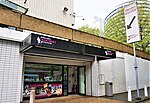Statue of Edward VI (Cartwright)

The statue of Edward VI by Thomas Cartwright at St Thomas' Hospital, Lambeth, London is one of two statues of that king at the hospital. Both commemorate Edward's re-founding of the institution in 1551. The statue was designed by Nathaniel Hanwell and carved by Thomas Cartwright in 1682, during the rebuilding undertaken by Sir Robert Clayton when President of the hospital. The statue originally formed the centrepiece of a group of figures which adorned the gateway on Borough High Street. It was moved to its current location at the north entrance to the North Wing on Lambeth Palace Road in the 20th century. It was designated a Grade II* listed structure in 1979.
Excerpt from the Wikipedia article Statue of Edward VI (Cartwright) (License: CC BY-SA 3.0, Authors, Images).Statue of Edward VI (Cartwright)
Westminster Bridge Road, London Lambeth (London Borough of Lambeth)
Geographical coordinates (GPS) Address Phone number Website Nearby Places Show on map
Geographical coordinates (GPS)
| Latitude | Longitude |
|---|---|
| N 51.4998 ° | E -0.1188 ° |
Address
St Thomas' Hospital
Westminster Bridge Road
SE1 7EH London, Lambeth (London Borough of Lambeth)
England, United Kingdom
Open on Google Maps









